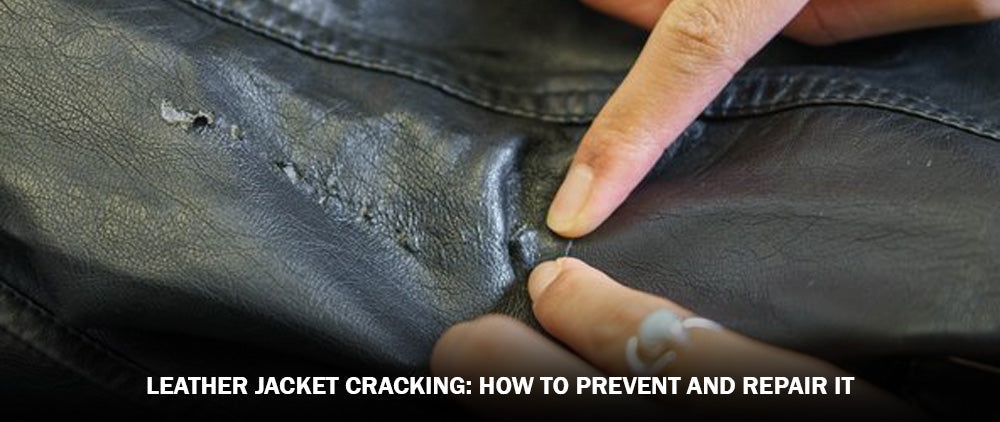Style, attitude, and classic fashion are all associated with leather jackets. Everyone, from motorcycle riders to fashion designers, values the unparalleled strength and appearance of genuine leather. But even the toughest leather will eventually show wear if it is not properly cared for.
Leather jacket cracking is one of the most prevalent and annoying problems; it not only shortens the lifespan of your cherished item of clothing but also affects its appearance.
You can preserve that smooth, supple finish for years by being aware of the reasons why leather cracks and taking preventative measures. We will look at the causes of leather cracking, how to avoid it, and how to repair leather cracks once they start.

Why Does Leather Crack?
Leather is made from animal hides and contains natural oils and moisture. To increase durability, leather undergoes a finishing process to transform it into a durable jacket. But over time, bad care and environmental factors can deplete its natural oils.
The fibres of the leather become brittle and eventually split as it dries out, causing the dreaded leather cracking.
Here are the top reasons your leather jacket may be cracking:
- Lack of Conditioning: Regular hydration is necessary for leather. It dries out without conditioning.
- Sunlight and Heat: Long-term exposure to heat sources or sunlight speeds up the drying process.
- Humidity Fluctuations: High humidity can harm untreated leather, and dry air draws moisture out.
- Improper Storage: Leather can develop cracks and mould if it is folded, crumpled, or stored in a moist environment.
- Harsh Chemicals or Cleaners: Products that are abrasive or have an alcohol base can remove protective coatings.
Does real leather crack? If neglected, yes. Real leather still needs regular upkeep, even though it is far more resilient than imitation leather.
How to Prevent Leather from Cracking
Preventing leather jacket cracking entirely is the best course of action. Prevention begins when you purchase your jacket and continues with regular maintenance.

- Keep It Moisturized
Leather requires moisture to maintain its softness and suppleness, just like your skin. Apply a high-quality leather conditioner every two to three months, or more frequently if you live in a dry climate.
- Select top-notch conditioners made especially for leather clothing. (Recommended: 8 Best Leather Conditioners to Protect Your Motorcycle Jacket)
- Use a gentle cloth to apply evenly.
- Before putting it on, let it absorb for the entire night.
This adds a thin layer of waterproofing and stops leather from cracking.
- Avoid Sunlight and Heat
Keep your leather jacket away from heat sources such as radiators and automobile interiors. Heat causes stiffness and eventually cracking by rapidly drying out the oils.

- Proper Storage
To keep your jacket in shape when not in use, hang it from a wide, padded hanger. Instead of using plastic, keep it in a breathable clothing bag.
- Do not compress or fold the leather.
- Keep out of direct sunlight and in a dry, cool place.
- To regulate humidity, use silica gel packets.
For more guidance, see our dedicated guide on How to Store Leather Jackets: A Detailed Guide
- Use the Right Products
Do not use household cleaners to clean your jacket. Use only leather-safe products, and start by testing any new cleaner on a discrete area.
Additionally, for simple at-home methods on softening jackets, check How to Soften Leather Jacket Quickly and Safely.

How to Repair a Cracked Leather Jacket
Sometimes damage is inevitable, even with the best care. There are multiple ways to fix cracks in leather, so don't worry about your bank when you have minor jacket damage.
- Assess the Severity
- Small cracks: These are surface-level and can typically be fixed with leather oil or conditioner.
- Deep Cracks: May need professional repair, dyeing, or filler.
- Peeling: Particularly prevalent in imitation leather, this may require an alternative method (see: How to Repair Peeling Faux Leather Jacket and Make It Look New Again).

- Repair Surface Cracks at Home
Regarding minor to moderate cracks:
Step 1: Clean the Area
To remove dirt, use a moist cloth and a gentle leather cleaner.
Step 2: Use leather oil or conditioner.
Apply a tiny bit of leather conditioner to the areas that are cracked. Give it time to absorb.
Step 3: Apply a leather filler if necessary.
Use a palette knife to apply leather filler to deeper cracks. Let it dry completely after smoothing it out.
Step 4: Recolor the Area
Color-correct the patched area with leather dye. Mix it in with the leather around it.
Step 5: Protect and Seal
Apply a leather sealant at the end to keep moisture in and shield the repair.
Larger repairs may require a leather specialist, but DIY kits are suitable for smaller jobs.

Can Improper Storage Cause Cracks?
Yes, definitely. Especially when people store leather jackets while traveling. It stays too long in a bag; sometimes, it can store moisture and cause cracks.
- Mold can grow in a humid environment and weaken the fibres of your jacket.
- The jacket may get creases from folding that eventually dry out and crack.
So, in case you wonder about it, read more: Can Leather Grow Mold? Causes, Signs, and How to Remove It

How to Keep Leather from Cracking Long-Term
The secret is consistency. This is a basic leather care routine:
- Using a dry microfiber cloth, dust off once a month.
- Apply leather conditioner every three months.
- Consider getting a professional cleaning and inspection once a year.
Want your jacket to last a lifetime? Read How Long Does a Leather Jacket Last with Maintenance? to see how proper care directly impacts lifespan.

Choosing the Right Jacket for Durability
Seek out premium materials if you're looking to buy a new jacket and want something that won't break easily. Compared to bonded leather, top-grain or full-grain leather is more resilient and handles wear better.
Our selection of men’s leather motorcycle jackets, which are made for both rough use and long-term durability, can serve as an inspiration. For equally fashionable options that require comparable maintenance, consider our leather vests for men and women.
Conclusion
Understanding how to stop leather from cracking starts with regular care, proper storage, and using high-quality products. Cracks in your leather jacket not only affect its look but also its durability.
With a bit of attention and the proper techniques, you can restore and maintain your jacket’s condition for years. Daniel Smart MFG offers premium leather motorcycle gear, including durable motorcycle jackets and vests, designed to last.
When you invest in quality and upkeep, your leather piece can remain as timeless and durable as the day you bought it.
Don’t wait—start protecting your leather today.
FAQs:
- How to fix cracked leather?
Deep cracks are best repaired with a combination of leather filler and dye, but superficial damage can be repaired with dye. Tip: Using a dye is your best bet if the interior of a crack is lighter in colour than the exterior.
- Will genuine leather crack?
With proper care, high-quality leather can develop a patina, age gracefully, and last for decades. Since real leather is animal skin, it must be cared for and kept moist; otherwise, it may crack and peel.
- Is it normal for leather to crack?
Yes, it is common for leather to crack over time, particularly if it is not properly maintained. Age, neglect, dryness, and exposure to adverse environmental conditions can all accelerate the process.


